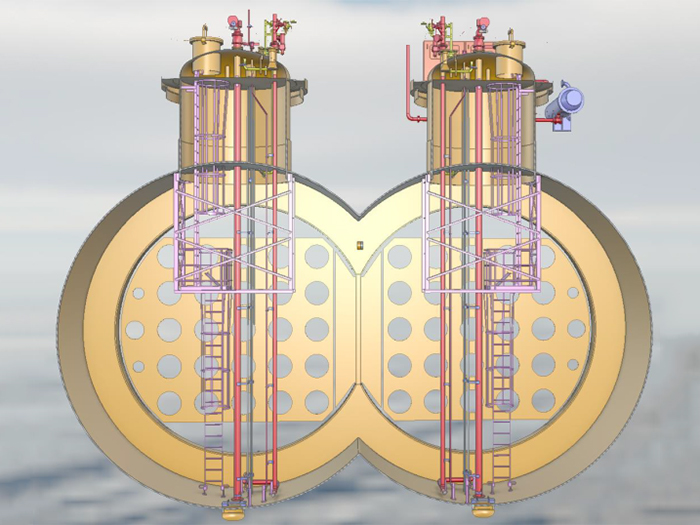
Tank solution offers effective way to transport captured carbon
Written by Nick Blenkey
The bilobe tank has a capacity of 8,000 cu. m and more than doubles the transportation capacity of liquid CO2 over current vessel capacity without the size, weight and stability concerns that would have come with a higher capacity “monolobe” design. [IMAGE: Høglund]
With Carbon Capture and Storage (CCS) likely to play an increasing role in combating climate change, there could be a growing market for marine transportation of captured carbon in the form of liquefied CO2.
Tønsberg, Norway, based automation, gas and system integration specialist Høglund Marine Solutions and Oldenburg, Germany, based HB Hunte Engineering expect the requirement for maritime CO2 transportation to scale up quickly.
In response, they have developed a breakthrough tank concept for LPG and CO2 transportation, based on existing, proven technology. They say their new system more than doubles current vessel cargo capacity to transport liquefied CO2.
Høglund and HB Hunte’s transportation solution uses a unique bilobe tank with a capacity of 8,000 cubic meters, drawing on cargo handling system and tank designs that they have previously proven in LNG, LPG and other sectors. The development of this unique solution came following a proof of concept request from gas technology specialists.
The solution is readily available for use in existing tanker designs. It is claimed to more than double the transportation capacity of liquid CO2 over current vessel capacity without the size, weight and stability concerns that would have come from a higher capacity “monolobe” design. It can be quickly adapted for LPG, giving extra flexibility to a vessel equipped with the solution.
The tank configuration, the companies say, is “a direct and positive impact for the use of different alternative material and reasonable fabrication processes while complying with IGC Code and convention rules. This allows the production of a solution which delivers substantially lower cost and risk than conventional very large diameter cylindrical type tanks offering the same capacity.”
Currently, the maximum capacity for transporting liquefied CO2 is approximately 3,600 cubic meters, or roughly 1,770 tonnes in dedicated CO2 tankers — predominantly owned by specialist operator Larvik Shipping, which has been transporting CO2 since 1988. However, as CCS chains develop, maritime transportation capacity needs to increase significantly, requiring innovation in tank design and cargo handling systems.
“With the global economy facing more pressure to reduce its carbon emissions, we must develop the technology for a viable CCS chain, and new ways of solving the complex challenges that come with upscaling CO2 transportation,” says David Gunaseelan, Vice President of Sales and Marketing at Høglund. “I’m thrilled to work with HB Hunte to develop a readily viable solution, which significantly broadens our horizons and demonstrates the cross-sector thinking needed to reduce atmospheric carbon levels in as many ways as possible. “
“CCS is a core technology area in realizing the important goal of a net-zero economy,” says Wolfgang Franzelius, Director Sales & Business Development at HB Hunte. “With new lines of finance emerging that support decarbonisation, we must develop the technology to achieve it at pace and scale. We are happy to team up with Høglund to support the development of safe and economical sea transport of captured carbon to a point where it cannot harm our planet.”




